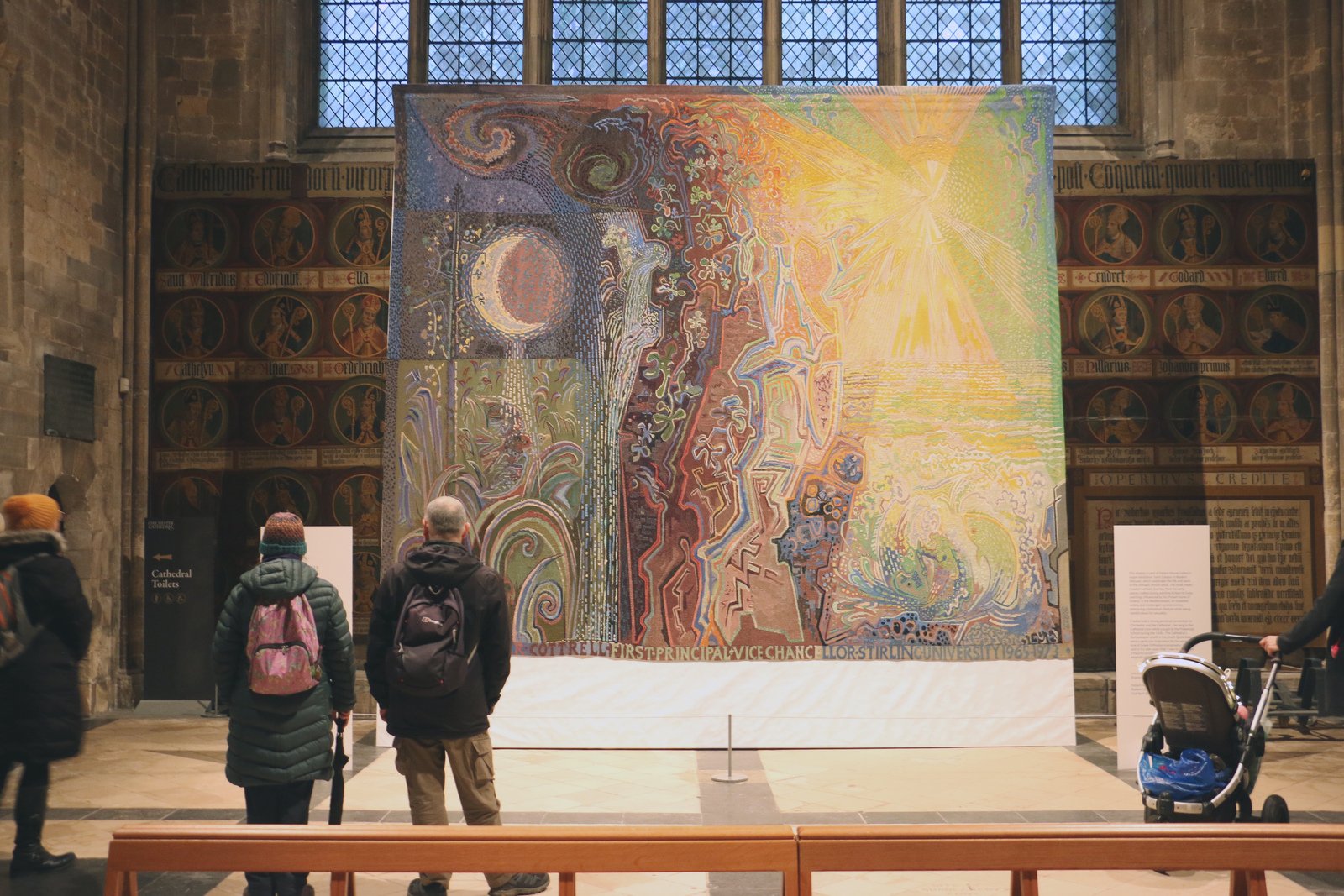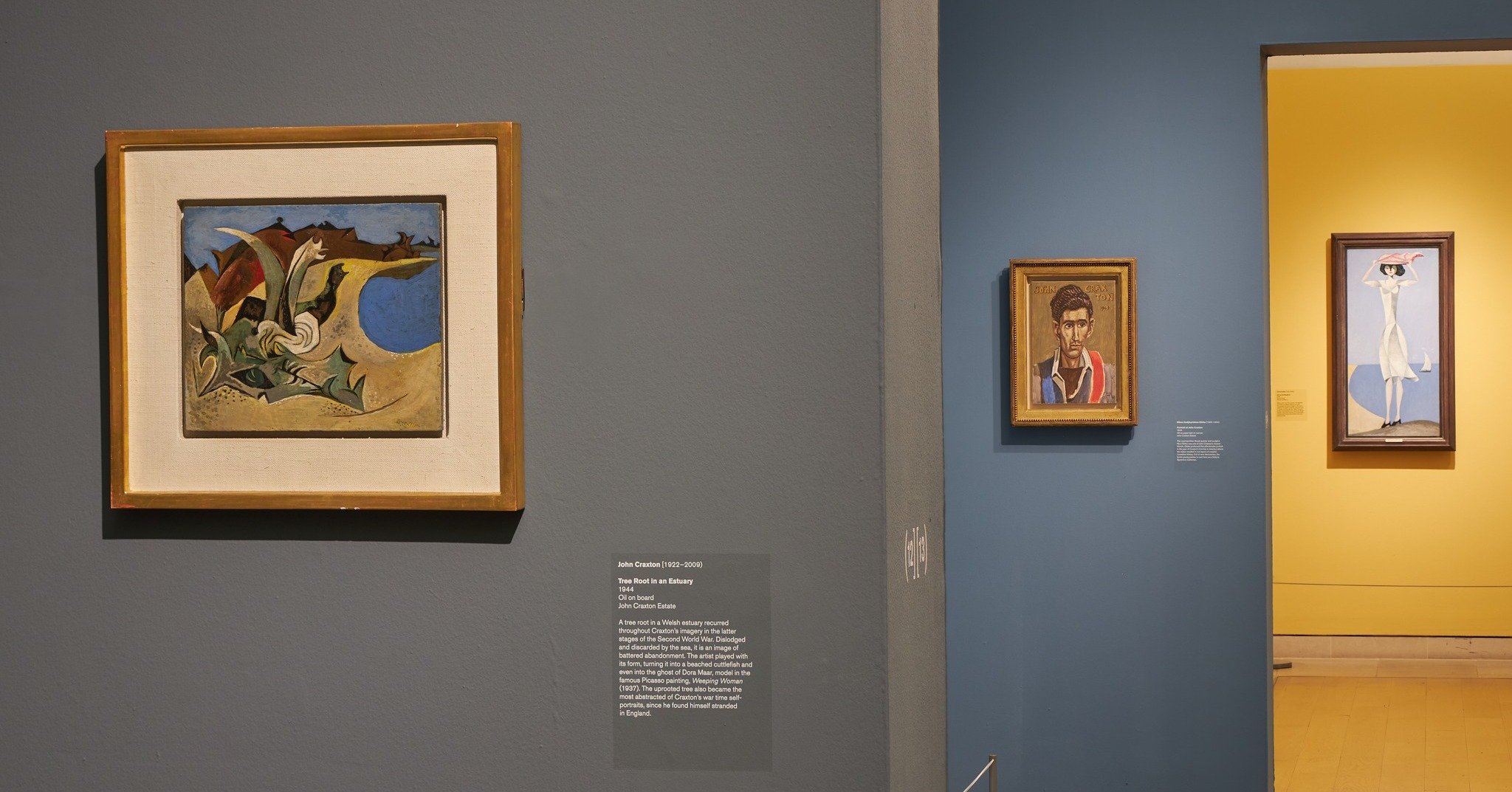John Craxton R.A.'s (1922-2009) enormous Cretan-inspired tapestry Landscape with the Elements (1975-76) is on display at Chichester Cathedral as part of Pallant House Gallery’s exhibition 'John Craxton: A Modern Odyssey' until 18th April 2024.
Below, our Canon Precentor, The Reverend Dr Daniel Inman provides insights into Craxton's artistic journey, exploring influences ranging from pagan themes to Byzantine traditions. This exploration delves into the complex relationship between the artist and spirituality, influenced by Craxton's upbringing in Chichester and a lifelong dedication to profound truths in art.
The sight of John Craxton’s Landscape with the Elements in our North Transept of the Cathedral is, in these darker winter months, a radiant display of Mediterranean warmth. It no doubt serves a similar purpose in the University of Stirling where it normally hangs, the result of a memorial commission and installed in the University in 1976. Woven in the Dovecot Studios in Edinburgh, it is one of the largest tapestries woven in Scotland and displays the full panoply of life, reflective of the seasons on Crete (where Craxton lived), and with an enormous range of colour drawing the viewer into what feels like a mythical drama. Ian Collins, Craxton’s biographer, wrote:
“Although a tribute to Scottish craftsmanship, the Craxton tapestry is all about the seasonal and diurnal life of Greece, and especially of Crete where Craxton had lived from 1960 (and where he was able to return in 1976 and be based for the last four decades of his life). Mediterranean sun and moon dominate the changing scene. Earth is suggested by Cretan rocks, plants and tree. Air by a flying bird. Water by rain, waterfall and Aegean-like sea, and Fire by flames which have set the top of the tree alight and by smoke changing into clouds. Loving Greek mythology as much as archaeology, the artist has actually depicted a goat being metamorphosed into a tree (becoming the thing it eats) and, rising too close to the sun, like Icarus, has caught on fire. Although the tapestry is deeply personal, with an idiosyncratic iconography, it shows the enormous impact on the artist of Byzantine mosaics.”[1]
 Landscape with the Elements (1975-76) at Chichester Cathedral
Landscape with the Elements (1975-76) at Chichester Cathedral
In one sense, as Collins points out, this is a pagan drama and perhaps not a natural exhibit within an Anglican cathedral. Yet, as Collins also indicates, Craxton remained influenced throughout his artistic life in Greece by the Byzantine tradition and its distinctive iconography – where the angular depictions and lack of perspective disrupts your own sense of viewing and invites you into a deeper reality.
Craxton was decidedly not religious in any conventional sense and, in his own reflections on exhibiting at Pallant House in 1998 he recorded his childhood spent in Chichester and Selsey and, in particular, his not altogether happy period at the Prebendal School as a chorister: “I owe it to Chichester for helping me to become a pagan….organized religion was not in my nature, especially its manifestation in Anglo-Catholic ritual, which I soon came to regard as theatrical, self-indulgent and, ultimately, false.”[2]
 'John Craxton: A Modern Odyssey' at Pallant House Gallery. Photo credit: Barney Hindle (2023)
'John Craxton: A Modern Odyssey' at Pallant House Gallery. Photo credit: Barney Hindle (2023)
Despite his dislike of the choir-school life, Craxton nonetheless records how both the School and Cathedral gave him a rich doorway into art. The Choir went on tour to Bruges and Ghent, where he encountered the Netherlandish School, and he spoke affectionately of Chichester’s choral retrieval of the Elizabeth masters of Tallis, Taverner, Gibbons and Weelkes under the Master of the Choristers of the time, Dr Harvey Grace.
Above all, Craxton spoke of the wonder of daily encountering our early 12th-century Romanesque reliefs of Christ’s Entry into Bethany and The Raising of Lazarus, which were rediscovered in the nineteenth century and caused a sensation at the time as some of the finest sculpture in England from that period – most of which, of course, had been destroyed during the Reformation: “that great art from the distant past could be without epoch: it could look fresh and immediate and modern, and clearly didn’t have to mimic nature to look real…those two reliefs stood steadfast, bearing witness through their deep conviction, devoid of sentimental bondeuserie.”[3]
 The Chichester Reliefs Raising of Lazarus (circa 12th century)
The Chichester Reliefs Raising of Lazarus (circa 12th century)
Just as Constantin Brancusi (1826-1957), the founder of abstract sculpture, and Wassily Kandinsky (1866-1944), the founder of non-figurative abstract painting, were both deeply interested in the true essence of things which they encountered in the distinctive order of Orthodox art, so in Craxton we arguably also see someone deeply affected by liturgical art and that quest for truth expressed in the use of gold and light and the distinctive figuration that marked religious art prior to Renaissance naturalism. His quest for that radiant flame, hidden behind all reality, is surely there as much in his erotically charged depictions of sailors as in something like Landscape with the Elements; Craxton was ineluctably drawn to something eternal and enduring and, for me, it is a welcome contrast from the nihilistic appropriation of Christian iconography by Francis Bacon during the same period.
In that sense, Chichester Cathedral left him with something more enduring – an ambiguous relationship with the divine (if not the Church of England) that was in evidence in his final recollections of Chichester:
‘We in England are so fortunate still to have our majestic and inspiring Romanesque and Gothic cathedrals, their almost Islamic-like architectural geometry more than enough to convince me that God exists. A cynic might add, ‘Existed, you mean’.[4]
 Landscape with the Elements (1975-76) at Chichester Cathedral
Landscape with the Elements (1975-76) at Chichester Cathedral
[1] Ian Collins, John Craxton: A Life of Gifts (New Haven, CT: Yale University Press, 2021)
[2] John Craxton, ‘Reflections on Exhibiting in Pallant House Gallery, Chichester, 1998’ in John Craxton: A Modern Odyssey (Chichester: Pallant House Gallery, 2023), 14,18.
[3] Ibid, 19.
[4] Ibid, 19.